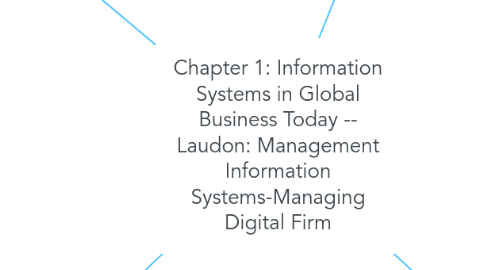
1. Emergence of the Digital Firm
1.1. New Yankee Stadium
1.2. technology
1.2.1. cloud computing
1.2.2. growth in software services
1.2.3. mobile digital platforms
1.2.4. social network apps
1.3. management
1.3.1. customer and supplier intimacy
1.3.2. virtual meetings proliferate
1.3.3. business intelligence
1.3.4. improved decision-making
1.3.5. operational excellence - greater efficiency
1.4. organizations
1.4.1. large investments in IT
1.4.2. web 2.0 widely adopted
1.4.3. telework gains
1.4.4. co-creation projects
1.4.5. new products, services, etc.
1.4.6. competitive advantage / survival
1.4.7. globalization
2. A set of interrelated components that produce information to support decision-making and control an organization.
3. Dimensions of Information Systems
3.1. Management (Problem Solvers)
3.1.1. Senior
3.1.2. Middle
3.1.3. Operational
3.2. Organizational Goals / Process
3.2.1. Value Adding
3.3. Information Technology
3.3.1. Hardware
3.3.2. Software
3.3.3. Data Management
3.3.3.1. Input
3.3.3.2. Process
3.3.3.3. Output
3.3.3.4. Feedback
3.3.4. Communication / Networking
3.4. Complementary Assets (optimize return from IT investments)
4. All business relationships with employees, suppliers and customers are digital.
5. Information systems are seen as a solution to business challenges.
6. Approaches to Information Systems
6.1. Technical
6.1.1. Management Science: Decision-making Models
6.1.2. Computer Science: Data Management and Access
6.1.3. Operations Research: Optimization of transportation, inventory control, transaction costs
6.2. Behavorial
6.2.1. Sociology: How Groups Affect Systems
6.2.2. Economics: Production, Markets, Control and Cost Structures
6.2.3. Psychological: How People Interpret Information
6.3. Sociotechnical
6.3.1. Management Information Systems: Mixing Hardware, Software, People and Social Context to solve real-world problems.
7. Examples
7.1. MIS in Your Pocket
7.2. UPS
7.3. Management Decision Problems
7.3.1. Snyders of Hanover
7.3.2. Dollar General
